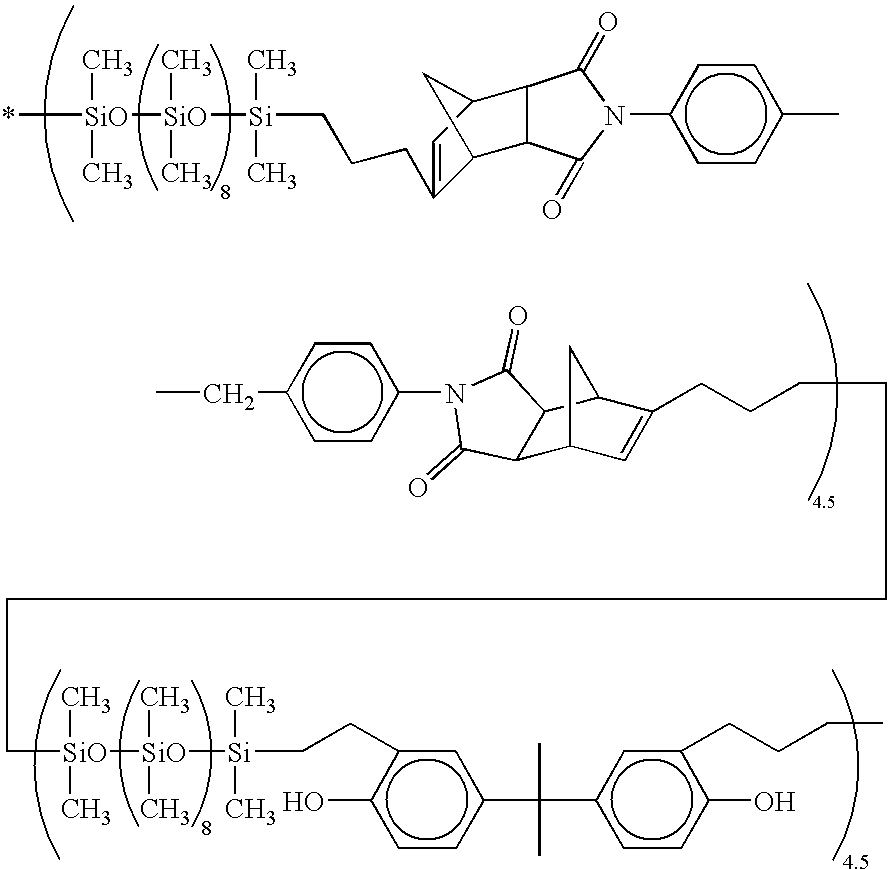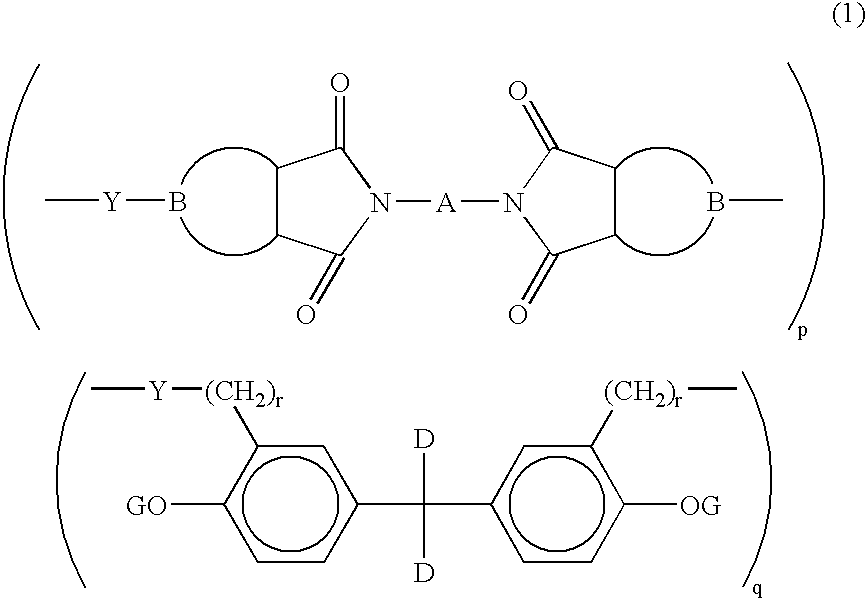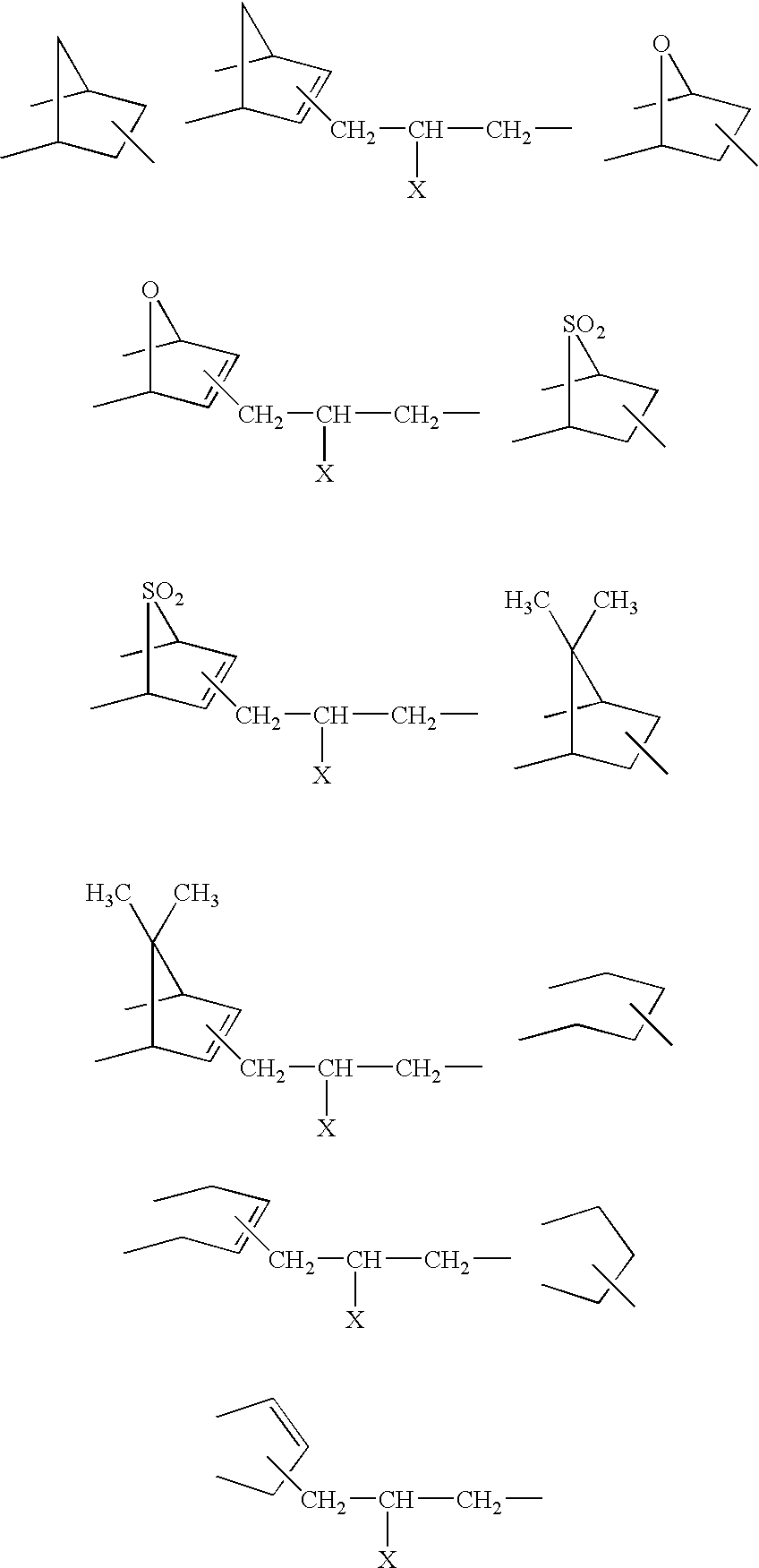Siloxane copolymer, making method, and thermosetting resin composition
- Summary
- Abstract
- Description
- Claims
- Application Information
AI Technical Summary
Benefits of technology
Problems solved by technology
Method used
Image
Examples
example 1
Synthesis of Siloxane Copolymer
[0078]A 2-liter flask equipped with a stirrer, thermometer and nitrogen purge line was charged with 114 parts (0.2 mol) of an olefinic carbon-to-carbon double bond-containing imide compound represented by the formula:
[0079]
290 parts (0.4 mol) of an organopolysiloxane represented by the following average structural formula:
[0080]
61 parts (0.2 mol) of diallyl bisphenol A and 500 parts of toluene, to which 0.3 part of a 2 wt % ethanol solution of chloroplatinic acid was added. The contents were stirred for 5 hours at 90° C. The solvent was removed from the reaction solution, yielding 405 parts of the target siloxane copolymer. This siloxane copolymer was a viscous fluid with a pale yellow clear appearance. It had a number average molecular weight of 10,500 as measured by gel permeation chromatography (GPC).
[0081]Based on the results of GPC and IR analysis, the siloxane copolymer was identified to have the following average structural formula.
[0082]
[0083]T...
example 2
Synthesis of Siloxane Copolymer
[0089]A 2-liter flask equipped with a stirrer, thermometer and nitrogen purge line was charged with 160 parts (0.28 mol) of an olefinic carbon-to-carbon double bond-containing imide compound represented by the formula:
[0090]
290 parts (0.4 mol) of an organopolysiloxane represented by the following average structural formula:
[0091]
37 parts (0.12 mol) of diallyl bisphenol A and 500 parts of toluene, to which 0.3 part of a 2 wt % ethanol solution of chloroplatinic acid was added. The contents were stirred for 5 hours at 90° C. The solvent was removed from the reaction solution, yielding 430 parts of the target siloxane copolymer. This siloxane copolymer was a solid with a pale yellow clear appearance. It had a number average molecular weight of 17,000 as measured by GPC.
[0092]Based on the results of GPC and IR analysis, the siloxane copolymer was identified to have the following average structural formula.
[0093]
[0094]The results of IR analysis are shown be...
example 3
Synthesis of Siloxane Copolymer
[0100]A 2-liter flask equipped with a stirrer, thermometer and nitrogen purge line was charged with 102 parts (0.2 mol) of an olefinic carbon-to-carbon double bond-containing imide compound represented by the formula:
[0101]
586.4 parts (0.4 mol) of an organopolysiloxane represented by the following average structural formula:
[0102]
and 800 parts of toluene, to which 0.5 part of a 2 wt % ethanol solution of chloroplatinic acid was added. The contents were stirred for 2 hours at 90° C. Thereafter, 170 parts (0.28 mol) of diallyl bisphenol A was added dropwise, followed by 3 hours of stirring at 90° C. The solvent was removed from the reaction solution, yielding 684 parts of the target siloxane copolymer. This siloxane copolymer was a liquid with a pale yellow clear appearance, having a viscosity of 33.2 Pa·s. It had a number average molecular weight of 7,600 as measured by GPC.
[0103]Based on the results of GPC and IR analysis, the siloxane copolymer was id...
PUM
| Property | Measurement | Unit |
|---|---|---|
| Temperature | aaaaa | aaaaa |
| Percent by mass | aaaaa | aaaaa |
| Percent by mass | aaaaa | aaaaa |
Abstract
Description
Claims
Application Information
 Login to View More
Login to View More - R&D
- Intellectual Property
- Life Sciences
- Materials
- Tech Scout
- Unparalleled Data Quality
- Higher Quality Content
- 60% Fewer Hallucinations
Browse by: Latest US Patents, China's latest patents, Technical Efficacy Thesaurus, Application Domain, Technology Topic, Popular Technical Reports.
© 2025 PatSnap. All rights reserved.Legal|Privacy policy|Modern Slavery Act Transparency Statement|Sitemap|About US| Contact US: help@patsnap.com



